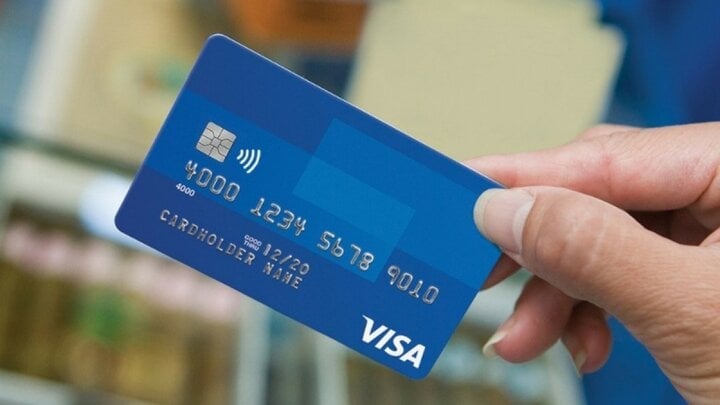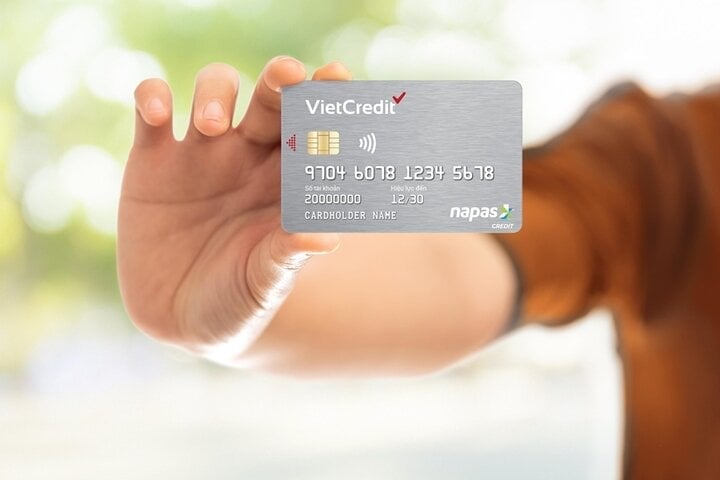What are Visa cards and domestic cards?
A domestic card is a domestic payment card that only allows customers to pay, deposit, withdraw or transfer money within the country. The distinguishing feature of a domestic card is the word “Napas” printed on the card.
Visa card is an international payment card issued by Visa in cooperation with banks. Visa cards include 3 types of credit cards (Visa Credit), debit cards (Visa Debit) and prepaid cards (Visa Prepaid). Customers can use Visa cards for domestic and international payments. Each Visa card has the word "VISA" on it to distinguish it from other card issuing organizations.
Similarities between Visa cards and domestic cards
International payment cards and domestic payment cards have the following similarities:
- Issued by banks: Both Visa cards and domestic cards are issued by banks. All card transactions are controlled, recorded and monitored by the bank throughout the process.

Visa card. (Illustration)
- Spending limit: Visa and domestic cards are both limited by a certain spending limit. This spending limit includes daily withdrawal limit, daily payment limit, daily money transfer limit... Each limit will depend on the card type and bank policy.
- Procedures and conditions for opening: Requirements for procedures and subjects for opening domestic cards and Visa cards are similar. Both types of cards can be opened online and directly at the counter.
- Payment method: Both Visa and domestic cards can be used for online transactions/payments via sales websites/applications and card swiping via POS machines.
- Multi-function: Visa and Napas cards can both be used to withdraw, transfer money at ATMs, at transaction counters or make payments.
The difference between Visa card and domestic card
Apart from some similarities, Visa cards and domestic cards have differences in terms of limits, fees, scope of use...
Regarding the card issuer : Domestic cards are issued by domestic banks and domestic financial institutions. Meanwhile, Visa cards are issued by international financial institutions such as VISA, JCB, MasterCard, American Express... in association with domestic banks.
Regarding scope of use: Domestic payment cards are only valid within the country. International payment cards can be used both domestically and internationally.
Security level: Domestic cards often use magnetic card technology while Visa cards often apply world security technology such as 3D security... with multi-layered, high-tech protection, protecting user information.
Fee schedule: For domestic cards, the issuance fee is from 30,000 - 100,000 VND, the annual fee is from 50,000 - 100,000 VND. For Visa cards, the issuance fee is from 50,000 - 100,000 VND and the annual fee is from 100,000 - 150,000 VND.
Limit: Domestic payment cards have a withdrawal limit of VND 50,000,000/day and a transfer limit of VND 100,000,000/day. Visa cards have a withdrawal limit of VND 100,000,000 - 200,000,000/day and a transfer limit of VND 250,000,000 - 500,000,000/day.
Should I get a visa or domestic card?

Domestic payment card. (Illustration photo)
Basically, Visa cards and domestic cards have the same functions. The biggest difference between these two types of cards is that international payment cards have a wider range of uses, higher fees and more incentives. Therefore, whether to use a Visa or domestic card depends on the purpose of each individual's card usage.
People who frequently make international payments, travel abroad or want to maximize convenience can open a Visa card. The advantage of this type of card is that it allows customers to withdraw money or make payments anywhere. In addition, when withdrawing money abroad with a Visa card, customers also enjoy preferential exchange rates and many preferential programs from the bank.
Meanwhile, people with normal spending needs should open a domestic card. The fee for using a domestic card is not too high but can still make necessary daily transactions and payments.
Lagerstroemia (synthesis)
Source





























![[Photo] National Assembly Chairman attends the seminar "Building and operating an international financial center and recommendations for Vietnam"](https://vphoto.vietnam.vn/thumb/1200x675/vietnam/resource/IMAGE/2025/7/28/76393436936e457db31ec84433289f72)






































































Comment (0)